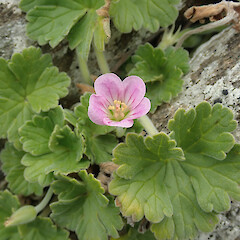Geranium traversii
Common name
Chatham Island geranium
Synonyms
Geranium traversii var. elegans Cockayne
Family
Geraniaceae
Flora category
Vascular – Native
Endemic taxon
Yes
Endemic genus
No
Endemic family
No
Structural class
Herbs - Dicotyledons other than Composites
NVS code
The National Vegetation Survey (NVS) Databank is a physical archive and electronic databank containing records of over 94,000 vegetation survey plots - including data from over 19,000 permanent plots. NVS maintains a standard set of species code abbreviations that correspond to standard scientific plant names from the Ngä Tipu o Aotearoa - New Zealand Plants database.
GERTRA
Chromosome number
2n = 54, 54-56
Current conservation status
The conservation status of all known New Zealand vascular plant taxa at the rank of species and below were reassessed in 2017 using the New Zealand Threat Classification System (NZTCS) – more information about this can be found on the NZTCS website. This report includes a statistical summary and brief notes on changes since 2012 and replaces all previous NZTCS lists for vascular plants.
Please note, threat classifications are often suggested by authors when publications fall between NZTCS assessment periods – an interim threat classification status has not been assessed by the NZTCS panel.
- Conservation status of New Zealand indigenous vascular plants, 2017 . 2018. Peter J. de Lange, Jeremy R. Rolfe, John W. Barkla, Shannel P. Courtney, Paul D. Champion, Leon R. Perrie, Sarah M. Beadel, Kerry A. Ford, Ilse Breitwieser, Ines Schönberger, Rowan Hindmarsh-Walls, Peter B. Heenan and Kate Ladley. Department of Conservation. Source: NZTCS and licensed by DOC for reuse under the Creative Commons Attribution 4.0 International licence.
2017 | At Risk – Naturally Uncommon | Qualifiers: IE, RR
Previous conservation statuses
2012 | At Risk – Naturally Uncommon | Qualifiers: IE, RR
2009 | At Risk – Naturally Uncommon | Qualifiers: IE
2004 | Range Restricted
Distribution
Endemic. Chatham Islands group. Known from all the main islands, islets and rock stacks except The Forty Fours, Sisters, Pyramid and Western Reef.
Habitat
Coastal cliffs, consolidated or mobile sand dunes, steep peat-filled crevices, limestone cliffs and rocks, rock crevices and erosion hollows.
Detailed description
Leafy, silvery grey to greyish-green, rosette-forming perennial herb forming patches up to 0.8 × 0.6 m. Caulorrhiza stout, deeply descending, woody at base, usually branched near ground level, often stoloniferous, up to 30 mm diameter, densely covered in persistent, frayed, petiole and stipule remnants. Stem and leaves usually densely covered in silvery hairs. Basal leaves on slender petioles up to 220 mm long. Stipules broad-ovate, cuspidate. Lamina 15–100 mm diameter, broad-reniform, orbicular, mostly lobed to ½ way but sometimes deeper; lobes 5–7–(8), cuneate, often toothed or lobed further. Cauline leaves similar but smaller. Flowers solitary 20–25–(30) mm diameter; peduncles up to 100 mm long, retrorsely hairy; bracteoles narrow-lanceolate, subacuminate. Sepals 7–11 × 2–4 mm, narrow-ovate to broad-ovate, densely covered with grey hairs, cuspidate. Petals 12–(16) × 10–(14) mm, broad-obovate or obovate-oblong, shortly clawed, pink or white, rarely pale purple, in all usually with up to 5 more darkly pigmented, longitudinal veins. Stamens < or > pistil. Mericarps silky hairy; beak 8–24 mm long. Seed 2.2–2.8 mm long, surface dull, dark brown, red-brown, dark purple-brown to black-brown, elliptic-oblong, not compressed, cells of primary reticulum, 4–6-sided, broadly oblong to isodiametric (0.04–0.15 mm long)
Similar taxa
Easily distinguished from all other indigenous and naturalised New Zealand geraniums by the stout rootstock and stems; by the leaves densely clad in more or less silvery hairs; and by the inflorescences bearing only sparse eglandular (never glandular) hairs with mainly pink or white (rarely pale purple) flowers with corolllas up to 25 mm diameter.
Flowering
July–June (peaking in summer)
Flower colours
Red/Pink, White
Fruiting
July–June
Life cycle
Seed dispersed by wind, ballistic projection and possibly attachment (Thorsen et al., 2009).
Propagation technique
Easily grown from fresh seed. Very amenable to cultivation thriving in most situations. Does not like excessive moisture and does best in full sun. In the wild it has a wide range of flower colours (white through pink to almost purple) and the leaves are occasional purple-coloured. Further selections may be rewarding. It is one of the few Chatham Islands endemics that is easily grown almost anywhere in New Zealand.
Threats
Not threatened. However, it has probably declined from large parts of its former range on Chatham and Pitt Islands. In some sites it may be threatened by invasive weeds, especially marram grass (Ammophila arenaria). It remains abundant and secure on all the outer vegetated islands except the Sisters, Forty Fours, Pyramid and Western Reef.
Etymology
geranium: From the Greek geranos ‘crane’, the fruit of the plant resembling the head and beak of this bird, hence the common name cranesbill.
traversii: Named after William Thomas Locke Travers (1819-1903) who was an Irish lawyer, magistrate, politician, explorer, naturalist, photographer. He lived in New Zealand from 1849 and was a fellow of the Linnean Society.
Attribution
Fact Sheet prepared by P.J. de Lange (14 April 2008). Description adapted from Aedo et al. (2005), supplemented with observations based on fresh and cultivated specimens.
References and further reading
Aedo C, Navarro C, Alarcón ML. 2005: Taxonomic revision of Geranium sections Andina and Chilensia (Geraniaceae). Botanical Journal of the Linnean Society 149: 1–68. https://doi.org/10.1111/j.1095-8339.2005.00432.x
Thorsen MJ, Dickinson KJM, Seddon PJ. 2009. Seed dispersal systems in the New Zealand flora. Perspectives in Plant Ecology, Evolution and Systematics 11: 285–309.
NZPCN Fact Sheet citation
Please cite as: de Lange, P.J. (Year at time of access): Geranium traversii Fact Sheet (content continuously updated). New Zealand Plant Conservation Network. https://www.nzpcn.org.nz/flora/species/geranium-traversii/ (Date website was queried)
















